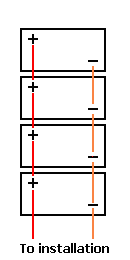I have an Aims 5000 inverter with two separate connections (2 positive and two negative posts) for attaching batteries.
I currently have two 6 volt batteries attached in series for a 12 volt system attached to the inverter and fed by the charge controller attached to the solar panels.
Question: can I simply add a second set of two 6 volt batteries attached in series only to the inverter. If only attached to the inverter and not directly to the other batteries will they still be recharged by the charge controller attached to the first set of batteries? If yes, is this set-up as effective as attaching all four batteries in the more traditional manner (series and parallel combination) or is the connection through the inverter as effective?
It would be cleaner to attach simply through the inverter if this works as effectively.
merci/thank-you
I currently have two 6 volt batteries attached in series for a 12 volt system attached to the inverter and fed by the charge controller attached to the solar panels.
Question: can I simply add a second set of two 6 volt batteries attached in series only to the inverter. If only attached to the inverter and not directly to the other batteries will they still be recharged by the charge controller attached to the first set of batteries? If yes, is this set-up as effective as attaching all four batteries in the more traditional manner (series and parallel combination) or is the connection through the inverter as effective?
It would be cleaner to attach simply through the inverter if this works as effectively.
merci/thank-you



Comment